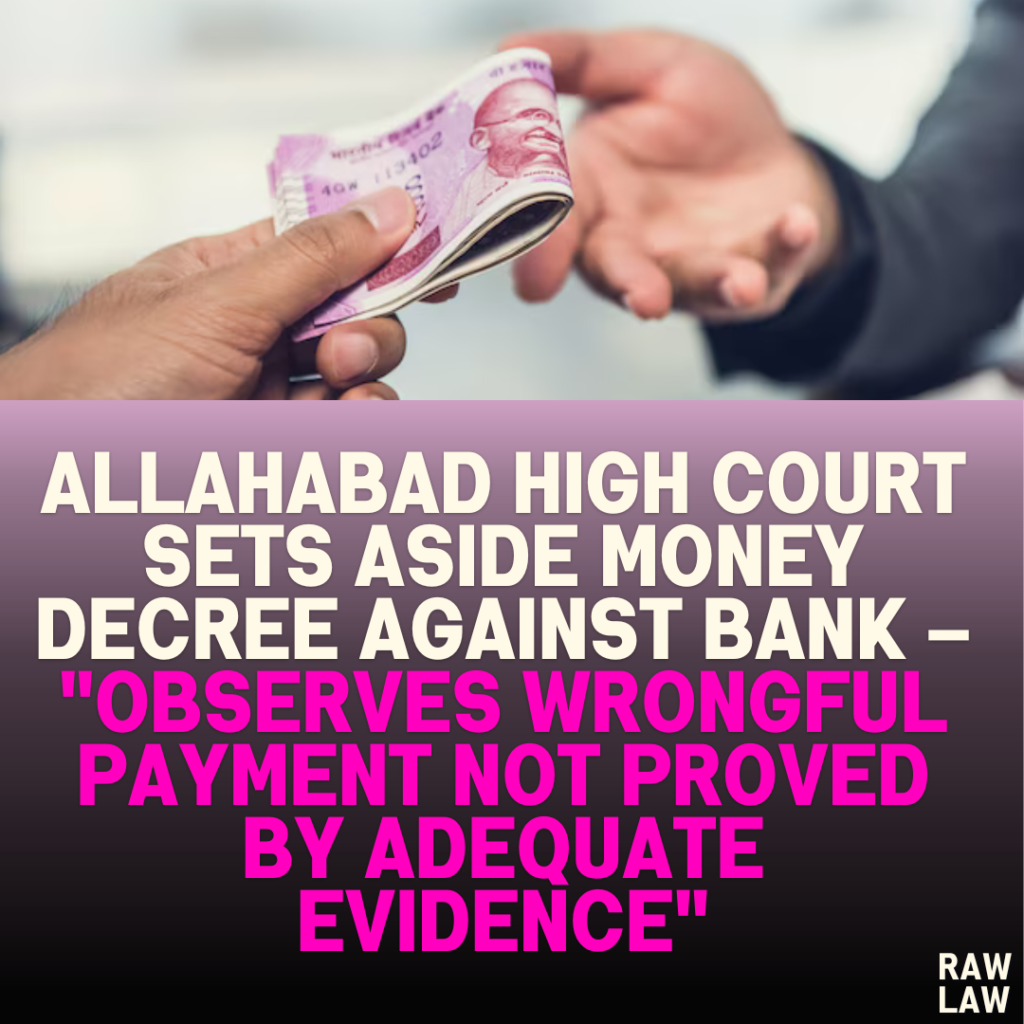Court’s Decision:
The Allahabad High Court set aside the money decree passed against the bank by the first appellate court, upholding the trial court’s decision to dismiss both original suits filed against the bank. The High Court found that the appellate court wrongly held the bank liable for negligence in clearing the cheques without adequate expert evidence proving forgery of signatures on the disputed cheques. Additionally, the court determined that the second suit was barred under Order 2 Rule 2 CPC.
Facts:
- Two separate original suits were filed against the bank, claiming amounts based on alleged fraudulent encashment of cheques bearing forged signatures.
- The first suit (Original Suit No. 143 of 1991) was filed for the recovery of ₹41,986.25 along with 24% interest per annum, asserting that one of the cheques was wrongfully cleared by the bank due to the forged signature of the plaintiff’s Managing Director.
- The second suit (Original Suit No. 176 of 1991) was filed in respect of six more cheques totaling ₹2,14,336.60, also alleging wrongful clearance due to the bank’s negligence and the involvement of the company’s employee in a conspiracy.
- The trial court dismissed both suits, citing a lack of evidence to prove negligence or forgery of the signatures.
- However, the first appellate court reversed the trial court’s decision, drawing a money decree against the bank based on its own comparison of disputed signatures.
Issues:
- Whether the first appellate court erred in accepting the case of the plaintiff by comparing the disputed signatures without expert evidence.
- Whether the bank was liable to return the amount involved in the cheques based on alleged negligence.
- Whether the second suit was barred under Order 2 Rule 2 CPC due to the omission of claims in the first suit.
- Whether the interest awarded to the plaintiff was in accordance with Section 34 of the Code of Civil Procedure, 1908.
Petitioner’s Arguments:
- The appellant argued that the first suit was filed based on a notice covering all seven cheques, and as no leave was obtained from the civil court before the institution of the second suit, it was barred by the provisions of Order 2 Rule 2 CPC.
- The appellant also contended that the first appellate court acted as an expert in analyzing the disputed signatures, which was beyond its jurisdiction and competence.
- It was further submitted that the bank’s officials acted diligently and there was no conspiracy, as evidenced by the absence of any bank officials being made accused in the criminal case initiated by the plaintiff.
Respondent’s Arguments:
- The respondent submitted that each cheque presented on different dates gave rise to separate causes of action, thereby justifying separate suits.
- The respondent argued that the first appellate court correctly invoked Section 73 of the Evidence Act to compare the signatures and that the bank was negligent in clearing the disputed cheques without proper verification.
Analysis of the Law:
The High Court examined the scope of Section 73 of the Evidence Act, which allows a court to compare disputed signatures but cautioned against a court acting as an expert. It held that the first appellate court’s detailed comparison of signatures, involving technical observations like pen-lift and pen-pass, was not within its purview and required expert evidence under Section 45 of the Act.
The court also discussed Order 2 Rule 2 CPC, which mandates that all claims arising from the same cause of action must be included in a single suit unless explicitly allowed otherwise. Since the plaintiff was aware of all seven disputed cheques at the time of filing the first suit, the second suit was barred.
Precedent Analysis:
The High Court referred to several precedents, including:
- State (Delhi Administration) vs. Pali Ram – cautioning against judges substituting their own comparisons for expert opinion.
- O. Bharathan vs. K. Sudhakaran and another – highlighting the Supreme Court’s stance on the need for expert evidence in disputed signature cases.
- Canara Bank vs. Canara Sales Corporation – emphasizing that a bank’s liability arises only when the customer is unaware of the forgery.
Court’s Reasoning:
The court concluded that the first appellate court’s reliance on Section 73 of the Evidence Act to compare the disputed signatures without expert assistance was misplaced. Further, the findings on negligence were unsupported by adequate evidence. The High Court upheld the trial court’s dismissal of both suits, observing that the bank had exercised due diligence and was not in collusion with any party.
Conclusion:
The High Court allowed both appeals, setting aside the money decree passed by the first appellate court and upholding the trial court’s decision. It directed the refund of any amount deposited by the appellant bank pursuant to interim orders.
Implications:
This judgment reiterates the principle that courts should not act as handwriting experts and emphasizes the importance of adhering to procedural requirements under Order 2 Rule 2 CPC. It serves as a cautionary reminder for plaintiffs to consolidate all claims arising from the same cause of action and underscores the limitations of a court’s power in disputed signature cases without expert evidence.



